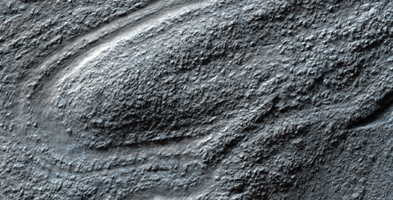
Figure 1
Click on the image for larger viewSome of the weirdest and least-understood landscapes on Mars are on the floor of the deep Hellas impact basin. This image was acquired in northwest Hellas where depths are more than 6 kilometers below the reference (or roughly the average) altitude for Mars.
There are what look like impact craters but are elongated, as if stretched in a viscous manner (like in a lava lamp). Some of the flowing landforms (Figure 1) are similar to those elsewhere in the middle latitudes of Mars, where the Shallow Radar (SHARAD) experiment on MRO has detected ice, but no ice detection has been reported here.
The floor of Hellas is relatively poorly mapped because it is often obscured by dust and haze in the atmosphere.
HiRISE is one of six instruments on NASA's Mars Reconnaissance Orbiter. The University of Arizona, Tucson, operates the orbiter's HiRISE camera, which was built by Ball Aerospace & Technologies Corp., Boulder, Colo. NASA's Jet Propulsion Laboratory, a division of the California Institute of Technology in Pasadena, manages the Mars Reconnaissance Orbiter Project for the NASA Science Mission Directorate, Washington. Lockheed Martin Space Systems, Denver, built the spacecraft.
Originally released March 28, 2012

